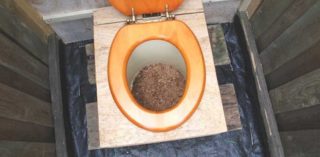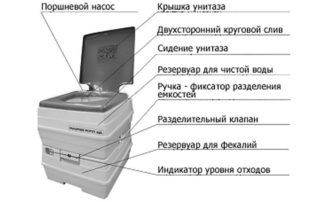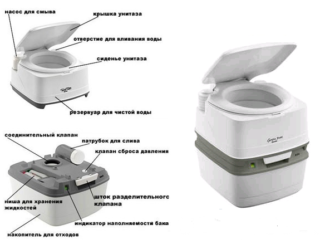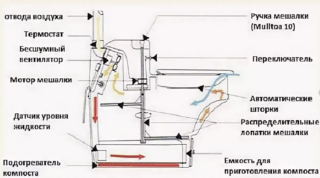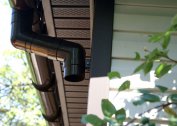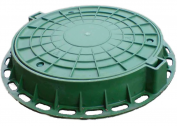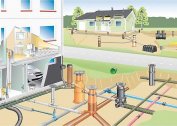A country toilet without a cesspool is an ergonomic device installed in areas where a sewer system has not been installed. There are several design options, each with its own advantages and imperfections.
Types of toilet installations
Common options for a country toilet without a cesspool: powder-closet, dry closet, amenities with chemical or electric cleaning.
Cumulative Closet Powder
The idea of equipping the restroom is as simple as possible. A regular toilet is being erected on the street in the form of a cubicle; a rather high pedestal with a seat is assembled in it. Immediately below the hole, a medium-sized tank is installed in which feces accumulate. In order to avoid unpleasant odors, sawdust and peat are used, which are initially covered with a layer of 10-15 cm. After they are sprinkled, new portions of excrement are dusted after each visit to the toilet.
The result is not only a washroom without sewage stench, but also fertilizer, since the contents of the tank can be mixed with compost.
To collect feces, it is better to choose not a bucket, but a plastic fifty-liter tank. It allows less frequent drainage. At the same time, significant efforts will not be required to remove the container and carry it. You can use a metal tank made of stainless steel or galvanized, but they are heavier. The drive must be airtight and have convenient grips or handles.
Dry closet
In summer cottages, they use purchased plastic cabins or create a construction with their own hands. This is a wooden house with a storage tank installed in it. Its volume (depending on model) is 12-24 liters.
The device is cleared as follows:
- From time to time, the biological agent is poured or poured into the drive.
- Microorganisms in its composition decompose waste products.
- The contents of the drive loses in volume and turns into an environmentally friendly, odorless mass.
Disposal of residues is carried out no more than once a month, and they can also serve as the basis for compost.
Peat varieties of dry closets are convenient. They have receivers where composting substrate based on peat is added. Waste already in the device itself becomes fertilizer, which must be unloaded once a year. Hydro decoupling or special valves helps to get rid of odors. For comfortable operation of the dry closet, a water supply is connected to flush the excrement, and also a ventilation riser is installed.
A septic tank is also a type of bio-device, but the decomposition of fecal matter occurs in special chambers. Usually there are two or more. If filters are installed, then the output is water purified to 95 percent. It can be watered a garden or a kitchen garden, used for technical needs.
Liquid chemical toilet
The device is similar to a dry closet that runs on bacteria, but special chemistry is used instead of a biological one. It allows you to process waste in the drive into a homogeneous, odorless mixture.
Among chemical compounds, ammonium or formaldehyde-based products are successful.
The first type is environmentally friendly. After processing, the waste can be dumped into a compost pit. Formaldehyde products are highly effective, but can harm soil and plants. Specialists are called in to remove the contents of the drive.
Electric dry closet
The device operates in a complex manner.First, the liquid phase is separated from the solid. Then the first one is purified and drained, and the second is processed into powder. The obtained dry raw materials can be used as fertilizer. There are options that bring the state of solid substance to the state of ash.
Electric toilets are convenient - you do not need to empty them and worry about preparations that decompose waste or fillers.
Advantages and disadvantages
In the presence of an autonomous toilet, the need for additional costs for arranging a local sewage system disappears. Designs can be installed on any site, regardless of its relief, type of soil and occurrence of underground sources, even indoors.
But with all the advantages, each device has disadvantages:
- Closet powder must often be emptied with daily use. He does not recycle simple toilet paper, biodegradable.
- Dry closets and latrines, cleaned with chemicals, require regular purchase of drugs, and if formaldehyde is used, then paid disposal of the contents.
- The toilet is dependent on the main source of electricity and costs a lot.
The most profitable option is a dry closet or a bio-septic tank. Bacteria are expensive, but can ensure absolute environmental safety of the site. They are used as fertilizer to clean pipelines and drains. In addition, biobacteria eliminate the sewer odor completely.
Choosing an installation location
 To arrange a toilet in the country without sewage do not take into account the depth of groundwater and the terrain, but some points must be taken into account:
To arrange a toilet in the country without sewage do not take into account the depth of groundwater and the terrain, but some points must be taken into account:
- The toilet must not be located next to the kitchen and dining room.
- It is necessary to install the facility far from water supply sources (the recommended distance is 25 m).
- The distance to the neighboring section should be at least 3 meters.
If you decide to arrange the amenities in the room, the most advantageous place for him is not far from the dressing room or under the stairs.
Toilet Materials
To build amenities on the street you will need:
- bars for the frame base;
- sheet plywood for wall cladding and seat fabrication;
- batten;
- nails, bolts, screws;
- slate, galvanized metal sheets, metal tile;
- door block.
If you do not want to build a seat manually, you will need to install a toilet. The most popular in country toilets are plastic products. Such systems are available without a tank, since there is no connection to the sewer.
Construction stages
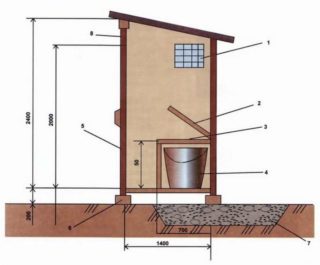 To build a toilet without a cesspool in the garden or in the country with your own hands, you first need to build a house. In terms of dimensions, it should not be less than 1x1.5x2.2m, so that a tall and large person could freely fit there.
To build a toilet without a cesspool in the garden or in the country with your own hands, you first need to build a house. In terms of dimensions, it should not be less than 1x1.5x2.2m, so that a tall and large person could freely fit there.
The erection of the building for the toilet step by step:
- A shallow strip foundation is poured. They dig in four pillars, fixing them with concrete, like piles.
- On the posts, the frame base of the front, rear and side walls of bars of 5 × 5 or 8 × 8 cm is fixed. The size of the front wall is 10 cm larger than the back one for tilting the roof.
- On the front wall, a reinforcement is made for a door of a corresponding size and an opening for a window. Wall frames are attached to the foundation by metal corners. Above and at seat level, a harness must be made.
- Sheathe the frame with plywood or wooden boards.
- All structural parts made of wood are treated with special antibacterial impregnation, which protects the wood from moisture and pests, and then coated with paints and varnishes.
- The roof of slate or metal profile is placed on the crate so as to build a visor.
- Doors are installed - wooden or plastic.
The stool is made of boards or lining.Either a plastic version is installed, but previously, a drive is arranged under it, and a ventilation riser is also mounted.
